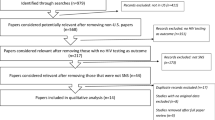Abstract
Social networks can be leveraged to identify undiagnosed HIV-infected individuals. The NC-LINK clinic-based testing initiative utilized these networks to achieve a 5% (95% CI 1.1–8.9%) positivity rate by providing free HIV testing to anyone who accompanied an HIV-infected patient to their clinic appointment. During 2013–2015, 120 individuals were tested at two clinics (N > 1000 patients each) in North Carolina, with 5 new and 6 total positive results. Of these, three linked to care within 30 days and all within 365 days. If expanded further, this initiative could significantly increase the number of HIV-infected individuals aware of their status.
Similar content being viewed by others
References
Bradley H, Hall HI, Wolitski RJ, Van Handel MM, Stone AE, LaFlam M, et al. Vital Signs: HIV diagnosis, care, and treatment among persons living with HIV—United States, 2011. MMWR Morb Mortal Wkly Rep. 2014;63(47):1113–7.
HIV Care Outcomes in North Carolina, 2016. North Carolina HIV/STD/Hepatitis Surveillance Unit Communicable Disease Branch. 2017 [cited November 22, 2017]. http://epi.publichealth.nc.gov/cd/stds/figures/factsheet_HIV_care_outcomes_2016_rev3.pdf.
Skarbinski J, Rosenberg E, Paz-Bailey G, Hall HI, Rose CE, Viall AH, et al. Human immunodeficiency virus transmission at each step of the care continuum in the United States. JAMA Internal Medicine. 2015;175(4):588–96.
Sullivan PS, Juhasz M, McNaghten AD, Frankel M, Bozzette S, Shapiro M. Time to first annual HIV care visit and associated factors for patients in care for HIV infection in 10 US cities. AIDS Care. 2011;23(10):1314–20.
Hall HI, Tang T, Westfall AO, Mugavero MJ. HIV care visits and time to viral suppression, 19 US jurisdictions, and implications for treatment, prevention and the national HIV/AIDS strategy. PLoS ONE. 2013;8(12):e84318.
Cohen MS, Chen YQ, McCauley M, Gamble T, Hosseinipour MC, Kumarasamy N, et al. Prevention of HIV-1 infection with early antiretroviral therapy. N Engl J Med. 2011;365(6):493–505.
Rothenberg R, Narramore J. The relevance of social network concepts to sexually transmitted disease control. Sexually Transmitted Diseases. 1996;23(1):24–9.
Bischof JJ, Bell LL, Pierce JK, Cooper KL, Heine AD, Quinlivan EB, et al. Detecting HIV among persons accompanying patients to an infectious diseases clinic. Sexually Transmitted Diseases. 2015;42(1):54–6.
North Carolina HIV/STD Epidemiologic Profile. North Carolina Department of Health and Human Services. 2015 [cited March 12, 2015]. http://epi.publichealth.nc.gov/cd/stds/epiprofile.html.
Liang TS, Erbelding E, Jacob CA, Wicker H, Christmyer C, Brunson S, et al. Rapid HIV testing of clients of a mobile STD/HIV clinic. AIDS Patient Care STDs. 2005;19:253–7.
Weidle PJ, Lecher S, Botts LW, Jones L, Spach DH, Alvarez J, et al. HIV testing in community pharmacies and retail clinics: a model to expand access to screening for HIV infection. Journal of the American Pharmacists Association. 2014;54(5):486–92.
Yehia BR, Ketner E, Momplaisir F, Stephens-Shields AJ, Dowshen N, Eberhart MG, et al. Location of HIV diagnosis impacts linkage to medical care. Journal of Acquired Immune Deficiency Syndromes. 2015;68:304–9.
Acknowledgements
This project is supported by the Health Resources and Services Administration (HRSA) of the U.S. Department of Health and Human Services (HHS) under Systems Linkages for Access to Care Initiative (H97HA22695) and support did not include nongovernmental sources. This information, content and conclusions are those of the authors and should not be construed as the official position or policy of, nor should any endorsements be inferred by HRSA, HHS or the U.S. Government. None of the authors have conflicts of interest to report. This study was conducted with the approval of the Institutional Review Boards of the participating institutions.
Author information
Authors and Affiliations
Contributions
All authors have contributed to the manuscript work, analysis, writing or editing and accept responsibility for publication. The authors also acknowledge the clinic staff, providers, and patients for their invaluable contributions to this research.
Corresponding author
Ethics declarations
Conflict of interest
None of the authors have conflicts of interest to report.
Research Involving Animal Rights
This article does not contain any studies with animals performed by any of the authors.
Research Involving Human Rights
All procedures performed in studies involving human participants were in accordance with the ethical standards of the institutional and/or national research committee and with the 1964 Helsinki declaration and its later amendments or comparable ethical standards.
Rights and permissions
About this article
Cite this article
LeViere, A., Donovan, J., Wilkin, A. et al. Results of a Social Network Testing Intervention for HIV in Infectious Disease Clinics. AIDS Behav 23 (Suppl 1), 48–51 (2019). https://doi.org/10.1007/s10461-018-2178-2
Published:
Issue Date:
DOI: https://doi.org/10.1007/s10461-018-2178-2




